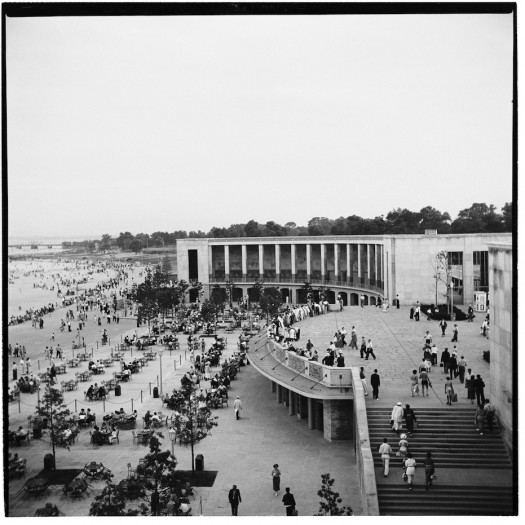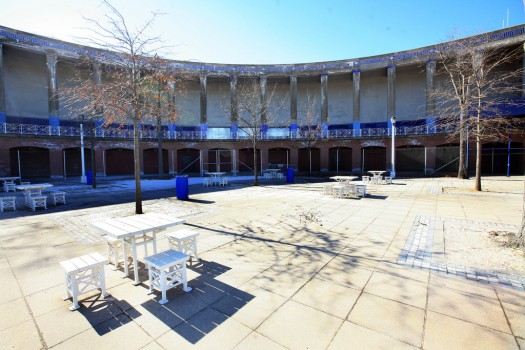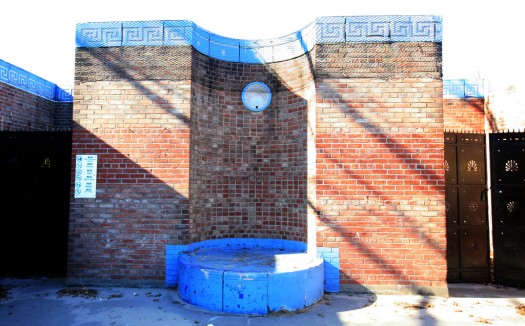
We are celebrating 15 years — and counting — of stories that are deeply researched and deeply felt, that build a historical record of what the city has been.
We are celebrating 15 years — and counting — of stories that are deeply researched and deeply felt, that build a historical record of what the city has been.
Deborah Wye is a seasoned curator of visual art, with over 30 years experience at the Museum of Modern Art, where she was most recently the senior curator of prints and illustrated books until her retirement late last year. Since then, she’s taken on a different kind of research project, one that marries her curatorial expertise with the passionate curiosity of a true urban enthusiast: the fascinating history and uncertain future of the Orchard Beach Pavilion at Pelham Bay Park in the Bronx. For Wye, a keen interest in the pavilion itself — the Depression-era politics of its development, the social story of its decades of public use, the architectural choices for the building itself — transformed into a desire to advocate on behalf of its preservation, so that “layers of history [can] be visible for the collective memories of New Yorkers.” To that end, she has curated an exhibition that is currently on view at the City Island Nautical Museum and has been presenting a related lecture about the building at interested forums throughout the city. She’ll be reprising this presentation for the Department of Bridges and Tunnels in December, the East Bronx History Forum in January, at the Bartow-Pell Mansion and the Bronx County Historical Society in the spring. In May of next year, she’ll present at the Bronx Central Library, where an abbreviated version of the exhibition will be on display.
For a deteriorating building whose history is most often overlooked, an advocate like Wye offers a fortuitous opportunity for a grass-roots approach to historic preservation to benefit from a professional command of art history and a passerby’s amazement at New York’s architectural treasures, some of which truly take us by surprise and capture our imagination. So we asked Wye to tell the story of how she discovered this building, how she went about researching it, and what her personal hopes are for its future.
– C.S.

The Orchard Beach Pavilion in 1937 | Photo courtesy of the New York City Parks Photo Archive, all rights reserved
A fenced-off landmark is languishing in the Northeast Bronx.
I can’t remember when the grand Orchard Beach Pavilion first grabbed my attention. It is a massive gray structure, hard to ignore, but it had an abandoned air about it — sitting there in the background of the beach experience, with no one seeming to notice it, even at the height of the season. But I began to look more closely, and as I started to notice its classical and Moderne details, I became curious about its function and its deteriorating condition. The Pavilion once served as the entry portal for changing rooms and lockers occupying areas behind each curving wing. And there were lots of shops and dining possibilities, for a quick snack or for lunch in a more formal setting with tablecloths. There was once a staffed medical station, and a police outpost that still functions today, as do Parks Department offices. But I believe that the way the Pavilion’s form responds to the curving beach was also meant to serve a dramatic, theatrical function, the focal point of a bold and ambitious public project.
When I discovered this monumental structure, it was a mess, and after a few years went by, even the concessions were closed up. Protective fencing was added to keep people away at a certain distance. Scaffolding appeared. I wondered if that was a good sign — that maybe some improvement was in store.
Although I live in Manhattan, I found out about this building when my husband and I bought a weekend house on City Island, which, to us native Bostonians, was like a funky Cape Cod. I began biking a lot and discovered nearby Orchard Beach — truly a wonder. It was off-season, before the Beach was teeming with people, some 1.4 million each year. I couldn’t believe the views I saw as I rode along the stone boardwalk that hugs the crescent-shaped shoreline. Somehow I knew — I can’t remember how — that Robert Moses was responsible for “inventing” this beach. Of course I had heard of Moses, having lived in New York briefly in the 1960s and then moving here permanently in 1979, but I wasn’t very knowledgeable about him. I only knew he was supposed to be bad. But with my good luck at finding Orchard Beach, as I looked out at the water, I could only say “thank you” to the much-maligned master builder.

Photo by Aurelija Cepulinskaite-Jara, for the 2010 Architectural League exhibition The City We Imagined/The City We Made
Once I retired from my position as Chief Curator of Prints and Illustrated Books at The Museum of Modern Art, in the fall of 2010, and finally had some free time, the first book I read was The Power Broker by Robert Caro, that riveting story of Robert Moses. But I also learned of a newer book, Robert Moses and the Modern City, from 2007, by Hilary Ballon and Kenneth T. Jackson, that offers a different perspective on Moses and acknowledged a range of accomplishments. Most helpful for me was the catalogue of projects from the 1930s (the period of the so-called “good Moses”), each described in great detail, including Orchard Beach.
I began taking courses on the history of New York City and its architecture, taking walking tours and joining all sorts of organizations in the “preservation community.” I was thrilled with the Landmarks Preservation Commission’s 2006 designation report on the Orchard Beach Pavilion, recognizing the beach project as “among the most remarkable public recreational facilities ever constructed in the United States.” I was inspired. I dove in and began studying the building in earnest, not only its architecture but its place in New York history. Moses became even clearer in my mind, and I also found out a lot about the remarkable Mayor Fiorello LaGuardia, and the impact of the Moses-LaGuardia team through FDR’s New Deal programs of the Great Depression.
The style of the WPA-funded Orchard Beach Pavilion, with its imposing but sleek monumentality, is sometimes referred to as “Federal Moderne” and it shares characteristics with many public buildings built through the Works Progress Administration in the 1930s. I realized by now that I was tackling my subject as if I were doing curatorial research for the kinds of exhibitions I have curated at MoMA. But this time, I had no real goal yet. I was just learning and amassing material. It was such a great subject!

From left: Pavilion Entry Balcony; Pavilion Collonade; and Pavilion Colonnade with Greek fret trim | Photos: Carl Foster, New York Landmarks and Preservation Commission, 2006
The project took me to places and parts of New York City I had never explored. My subway map was worn out and taped together. In the Bronx, I visited Marianne Anderson, the administrator for Pelham Bay Park, the park in which Orchard Beach is the star attraction. She very nicely gave me a tour of all the closed-off parts of the Pavilion, which are alarming in some cases. And I met Librarian Laura Tosi at the Bronx County Historical Society, in a neighborhood where I also saw the historic 1758 Valentine-Varian House and the Williamsbridge Oval Park, another Moses project of the 1930s. I walked the extraordinary Grand Concourse to learn more about Art Deco, since the Pavilion is often cited for its Deco details. I joined the Friends of Pelham Bay Park, an advocacy group, in hopes of finding others who might share my passion for the Pavilion, and then began to attend meetings of the East Bronx History Forum. But my research also brought me beyond the Bronx, to the Parks Department’s Olmsted Center in Queens, where a bonus was the nearby Queens Museum of Art (originally the New York City Building for the 1939 World’s Fair) by the architect Aymar Embury II, who is also credited with the design of the Orchard Beach Pavilion.

Other examples of Aymar Embury’s civic architecture in New York. From left: the New York City Building at the 1932 Worlds’ Fair (now the site of the Queens Museum of Art) photo courtesy of the New York City Parks Photo Archive; the Prospect Park Zoo, photo: Deborah Wye; the pavilion at Jacob Riis Park, photo: Deborah Wye
There was more research and more travel — to the lovely Prospect Park Zoo, where the exterior is much the same as when Embury designed it in 1935 (which isn’t the case for Central Park’s Zoo, also designed by him at about the same time but now drastically altered). I made my way to Jacob Riis Park, where Moses and Embury worked together, and the buildings share the sleek classicizing aesthetic of the Orchard Beach Pavilion, something both men favored. In fact, Moses believed that structures for the public should be traditional rather than avant-garde in style. And he found the perfect collaborator in the rather conservative Embury, who served as the Parks Department Consulting Architect for hundreds of projects. Embury was also an architectural historian, a Princeton graduate, and an accomplished and well-educated man generally, exactly the kind of Ivy-Leaguer that Moses, a Yalie himself, always preferred for his top team.
I also discovered the places where New York history professionals and amateur “buffs” like myself spend lots of time, from the Municipal Archives to the Milstein Division of the New York Public Library. Photo archives were another story. One stand-out was the immense collection of 1930s photographs of New York City taken by Berenice Abbott for a WPA project and available on the Museum of the City of New York’s website. While Moses made sure Orchard Beach was carefully documented in photographs for the Parks Department, some great images were also taken at the time by the firm of Gottscho-Schleisner.
So, what happened with all this research? It turns out that last summer, July 25 to be exact, was the 75th anniversary of the dedication of Orchard Beach. I seemed to be the first one to realize that, even taking the Pelham Bay Park Administrator by surprise.
When talking about my project with Barbara Dolensek, Vice President of the City Island Historical Society and Nautical Museum, she suggested a 75th anniversary exhibition. That opened in July with about 55 photographs. The community is enjoying the show, which has had some good coverage in the local press, and my PowerPoint talk got a standing-room-only crowd. (Granted, it’s a small place!) Now, I’m taking this illustrated talk “on the road,” so to speak, in order to garner interest in the Pavilion.
I want people to know about it, to give it the recognition it deserves. I want these layers of history to be visible for the collective memories of New Yorkers. Today, the Parks Department is in the midst of a scoping process for a possible restoration of the Pavilion. They have received bids for a six- to nine-month study of the building that will result in proposals for various options: restoration, partial restoration, and also replacement buildings. Community meetings will be part of that process, and I’m gathering names at my talks so I can contact people about them.
The building might be beyond repair. It seems to have a concrete condition called alkali silica reaction, which is disfiguring the building and could be eating away at its foundations. If the Pavilion is actually in dangerous condition, of course measures will need to be taken. But hopefully, this process will mean at least partial restoration, as well as a re-vamping so it can serve as a modern recreation center that fulfills the needs of the community. The residents of the Bronx, as well as those from the rest of the city and beyond, deserve to have this extraordinary example of civic architecture accessible. Great buildings can make people feel great. Even the inimitable Robert Moses thought so. In a quote that might sound a bit corny now, I think he got it right: “I believe in bigger and better construction for public recreation because I am satisfied that it makes people better.”
Personally, I’m not averse to a solution for the building that would combine old elements with new ones. I just want restoration to ensure that visitors can remember the New York history embedded in this structure. It represents a time that is mostly forgotten — the depth of the Great Depression and the massive federal response engineered by FDR, the idealism that was once part and parcel of grand civic architecture, and the leaders with huge personalities who were somehow able to accomplish great feats for New Yorkers. The scale and ambition of the Orchard Beach project, embodied in the Pavilion, seems unthinkable today. But its evocative style is a tangible reminder of the period — this was the 1930s and this is what public buildings looked like. It has an unmistakable symbolic resonance.
All of this might seem like a rationale for letting the building just sit there, to serve as a kind of museum artifact. That’s not what I want. I want people to make use of the building and fully experience its architecture. I can think of so many ways for it to function, in addition to dining, relaxing, and overlooking the beach. How about holding a wedding there? The building could house exercise rooms with equipment, there could be yoga classes. What about interactive displays for children, installations by local artists, and presentations of Bronx history? There is room for a skate park, for a pool, and for so many other things. But such plans need active community involvement. I hope I can help make that happen.
So now, I continue to visit the Pavilion — like an old friend — to pay respects and stay inspired. And I also say a quick good-bye each week on the way back to Manhattan as we cross the City Island Bridge and see the huge, mysterious structure from a distance across the water.

Photo by Aurelija Cepulinskaite-Jara, for the 2010 Architectural League exhibition The City We Imagined/The City We Made
Deborah Wye was a curator at The Museum of Modern Art for 31 years, before retiring in 2010. She now works for the Museum on a part-time basis, preparing a catalogue raisonné of the prints of Louise Bourgeois.
The views expressed here are those of the author only and do not reflect the position of Urban Omnibus editorial staff or the Architectural League of New York.
The views expressed here are those of the authors only and do not reflect the position of The Architectural League of New York.
Comments